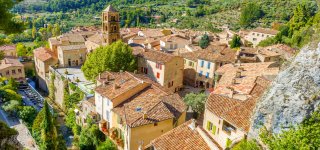The village of Moustiers-Sainte-Marie
Ranked among the "Most Beautiful Villages of France" Moustiers-Sainte-Marie is full of sublime architectural ensemble formed by its walls, its church and its chapels, its aqueduct and fountains. The stone carved into the tiles and bring the scenery of the village soft colors and relaxing.
Village a few hundred inhabitants in the year Moustiers lives of its tourist attractions, but also earthenware, local tradition for centuries. Capital of earthenware Moustiers-Sainte-Marie is a land of potters that houses a dozen manufacturing facilities.
The history of earthenware Moustiers since the Middle Ages, where the ceramic art consisted of making objects glazed earthenware. It was Pierre Clérissy the 17th century, who developed the art of earthenware Moustier with the secret of the blank email that he had learned of an Italian monk. When Louis XIV replaced the gold and silver by earthenware (bailing out the royal treasury by the consolidation of the precious metal parts), production workshops of Moustiers experienced a boom and a growing reputation throughout Europe . After two centuries of prosperity of the industry of the pottery in the village, fashion china is right Moustiers workshops. It will take the initiative of Marcel Provence to see potters revive activity in the municipality.
The museum earthenware exposes a sublime collection of pieces from the 17th century to the present, including specimens of great historical value. We learn, through a film, the manufacturing steps of earthenware Moustiers and its history. The artists' shops and studios animate the heart of the village alongside the bars with terraces and restaurants of the region.
Village of the Regional Natural Park of Verdon, Moustiers-Sainte-Marie is also part of the nature reserve classified by UNESCO Geopark Haute-Provence. Its surroundings are so rich in unspoilt nature, diverse landscapes, but also of important geological sites to trace the history of the planet hundreds of millions of years.
Free or guided tours of the village of Moustiers-Sainte-Marie invite you to discover the built heritage of the village and its main attractions.
At the heart of the village, the Church of Our Lady of the Assumption, originally Romanesque building, was partly rebuilt in a Gothic style between 1336 and 1361 under the orders of Cardinal Peter Pratis. It now sports a remarkable four Romanesque bell tower of Lombard levels built in tufa, a choir of Gothic style, and a Provençal Romanesque nave. The originality of the building also lies in its choir that is not located in the alignment of the nave.
The religious heritage of Moustiers also includes a chapel built on the heights of the village, which dominates the town: the Notre-Dame de Beauvoir joined by climbing nearly 300 stone steps cut into the hillside. The ascent is marked by the 14 stages of the cross. Built in the 12th century on the ruins of a temple from the 5th century, the Notre-Dame de Beauvoir offers from its promontory a breathtaking panorama of the valley and on the plateau of Valensole. In the village cemetery, St. Anne's chapel dates for its 16th century. It was built with the stones of a part of the ramparts.
Nestled in a narrow valley, the decor of Moustiers evokes a nursery Provencal nativity. Above the town, a towering star is suspended from a chain drawn between the two cliffs. Its origin is shrouded in mystery. After the fall of the previous, the current star is the eleventh to adorn the sky of the village. It dates from 1957. Its size is 125 cm wide. The channel on which it is suspended measuring 135 meters and alone weighs 150 kilograms.
